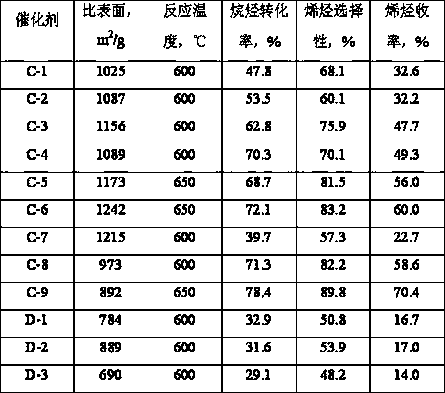Low-carbon alkane dehydrogenation olefin preparation catalyst and preparation method thereof
A technology for low-carbon alkanes and low-carbon olefins, which is applied in the field of catalysts for dehydrogenation of low-carbon alkanes to olefins and their preparation, and can solve problems such as unfavorable environmental friendliness and the like
- Summary
- Abstract
- Description
- Claims
- Application Information
AI Technical Summary
Problems solved by technology
Method used
Image
Examples
Embodiment 1
[0065] Weigh 50g of ammonium phosphate, dissolve it in 200mL of deionized water to obtain solution A; grind 100g of petroleum coke into powder, then add it to solution A, let it stand for 1.5h, then filter, and put the obtained solid sample in an oven at 110°C Dry for 5h. At 200°C, pretreat the dried solid sample with water vapor for 3 hours (the volumetric space velocity of the water vapor gas is 500 hours -1 ), then raise the temperature to 400°C, continue pretreatment for 3h, and then cool to 60°C under nitrogen protection to obtain pretreated petroleum coke.
[0066] Mix 8g of cetyltrimethylammonium bromide, 40g of citric acid and 200g of deionized water evenly to obtain solution B, weigh 22.25g of tetraethyl orthosilicate, and mix it with the above-mentioned pretreated petroleum coke and solution B Mix evenly, stir for 4 hours, and dry the obtained colloid at 120° C. for 4 hours to obtain silicon-based modified petroleum coke.
Embodiment 2
[0071] Weigh 50g of ammonium phosphate, dissolve it in 200mL of deionized water to obtain solution A; grind 100g of petroleum coke into powder, then add it to solution A, let it stand for 1.5h, then filter, and put the obtained solid sample in an oven at 110°C Dry for 5h. At 200°C, pretreat the dried solid sample with water vapor for 3 hours (the volumetric space velocity of the water vapor gas is 800 hours -1 ), then raise the temperature to 400°C, continue pretreatment for 3h, and then cool to 60°C under nitrogen protection to obtain pretreated petroleum coke.
[0072] Mix 8g glutaric acid, 40g hydrochloric acid (concentration 1.5moL / L) and 230g deionized water evenly to obtain solution B, weigh 22.25g tetraethyl orthosilicate, and mix with the above-mentioned pretreated petroleum coke and solution B Evenly, stir for 4 hours, and dry the obtained colloid at 120° C. for 4 hours to obtain silicon-based modified petroleum coke.
[0073] Weigh 11.3g of potassium permanganate a...
Embodiment 3
[0077] Weigh 50g of ammonium phosphate, dissolve it in 200mL of deionized water to obtain solution A; grind 100g of petroleum coke into powder, then add it to solution A, let it stand for 1.5h, then filter, and put the obtained solid sample in an oven at 110°C Dry for 5h. At 200°C, pretreat the dried solid sample with water vapor for 3 hours (the volumetric space velocity of the water vapor gas is 1200 hours -1 ), then raise the temperature to 400°C, continue pretreatment for 3h, and then cool to 60°C under nitrogen protection to obtain pretreated petroleum coke.
[0078] Mix 8g of dodecylamine, 40g of absolute ethanol and 230g of deionized water uniformly to obtain solution B, weigh 22.25g of tetraethyl orthosilicate, mix with the above-mentioned pretreated petroleum coke and solution B, stir for 4h, Solid-liquid separation, the resulting solid was washed with deionized water until the filtrate became neutral, and then dried at 120°C for 4 hours to obtain silicon-based modif...
PUM
 Login to View More
Login to View More Abstract
Description
Claims
Application Information
 Login to View More
Login to View More - R&D
- Intellectual Property
- Life Sciences
- Materials
- Tech Scout
- Unparalleled Data Quality
- Higher Quality Content
- 60% Fewer Hallucinations
Browse by: Latest US Patents, China's latest patents, Technical Efficacy Thesaurus, Application Domain, Technology Topic, Popular Technical Reports.
© 2025 PatSnap. All rights reserved.Legal|Privacy policy|Modern Slavery Act Transparency Statement|Sitemap|About US| Contact US: help@patsnap.com

